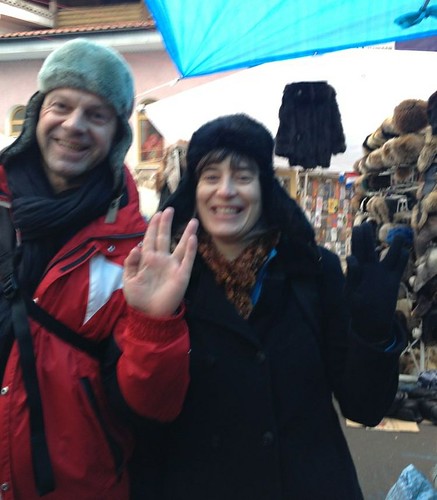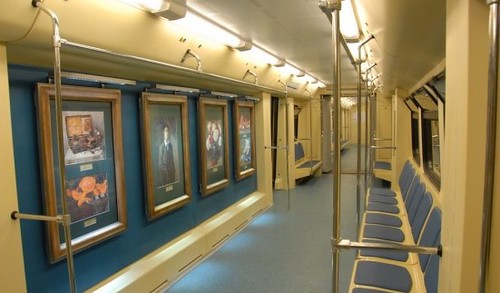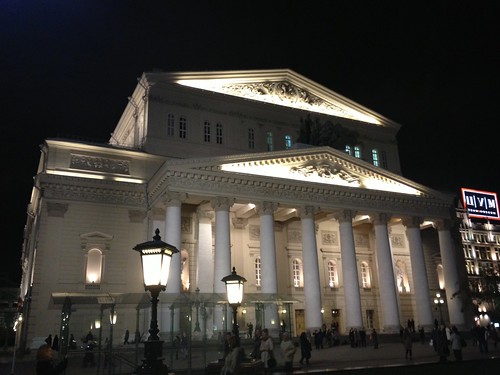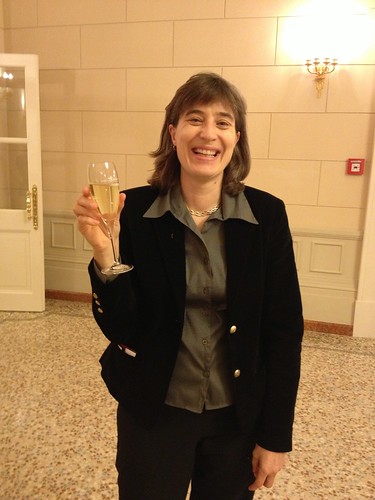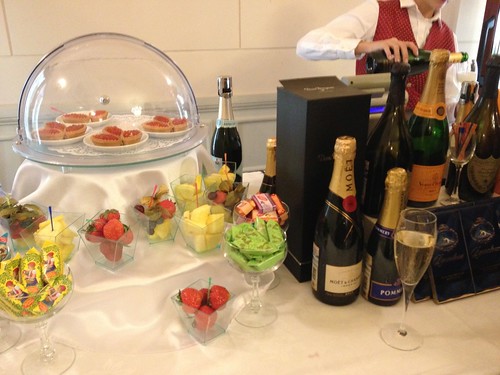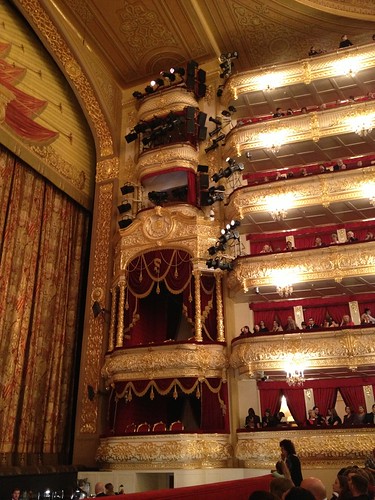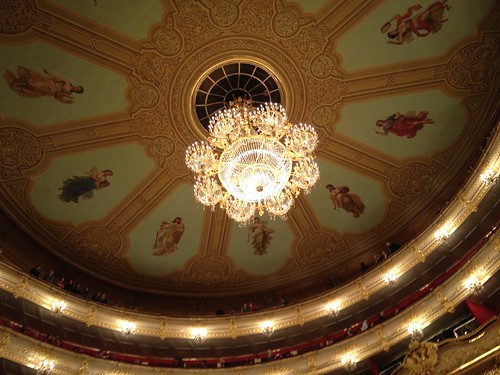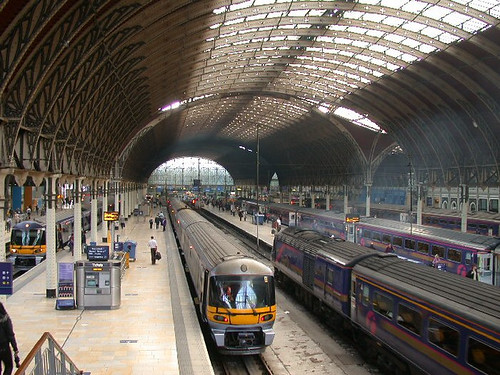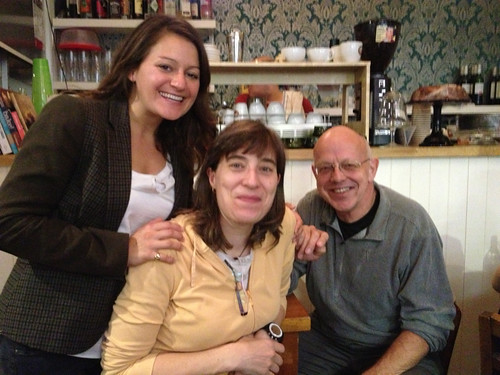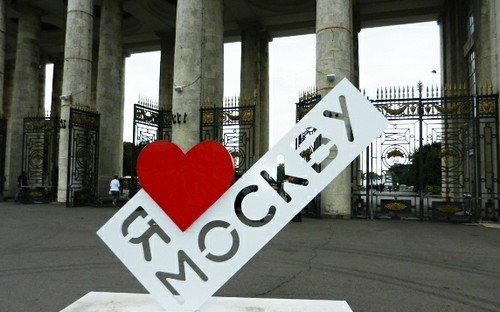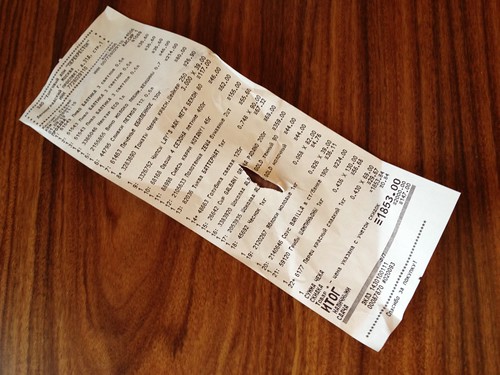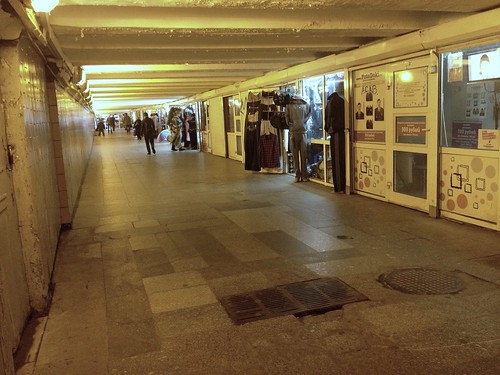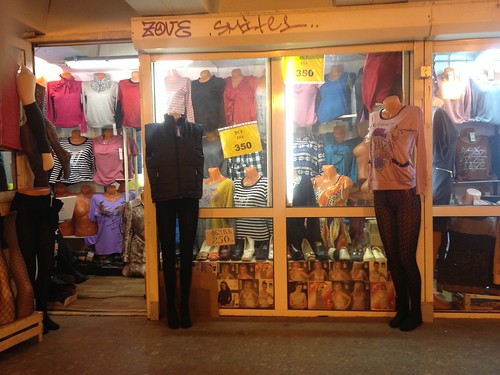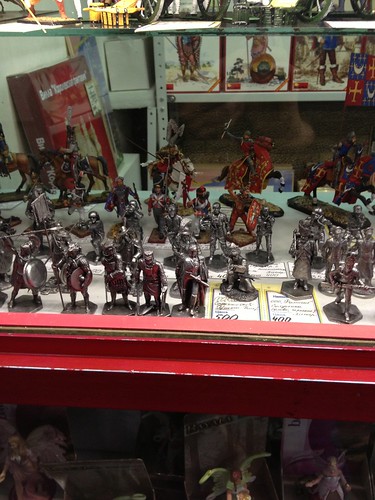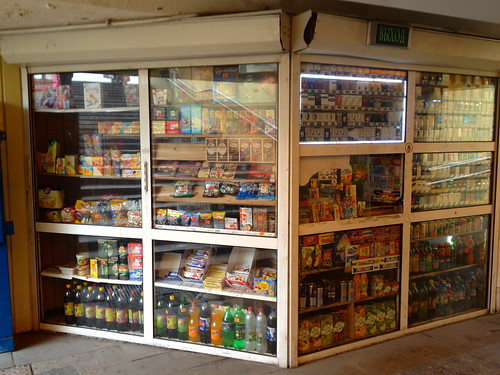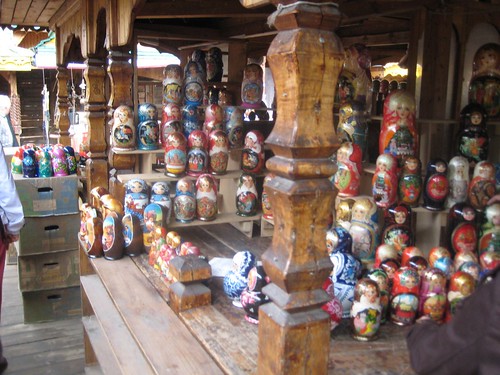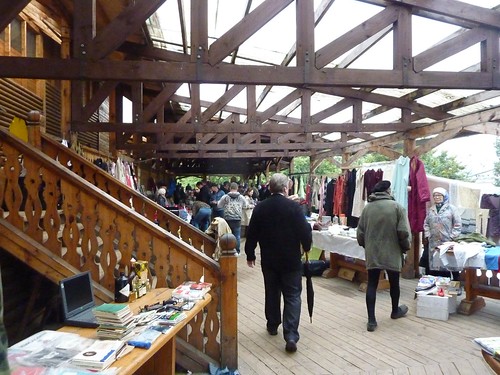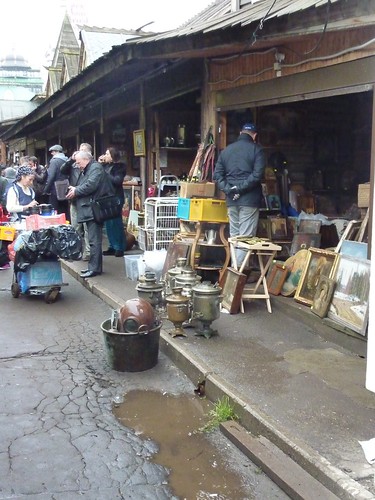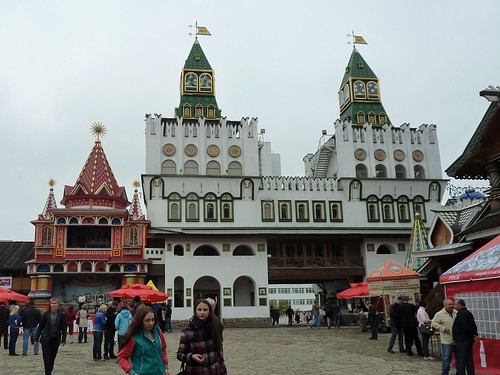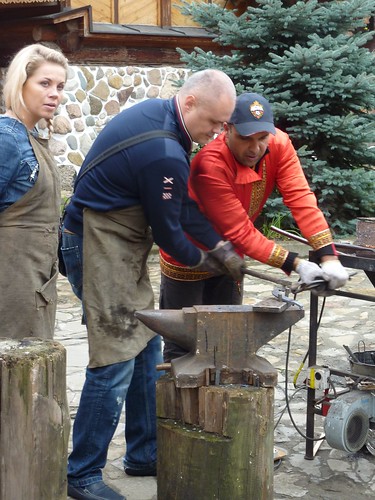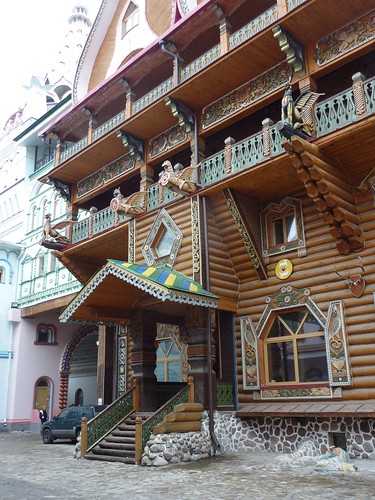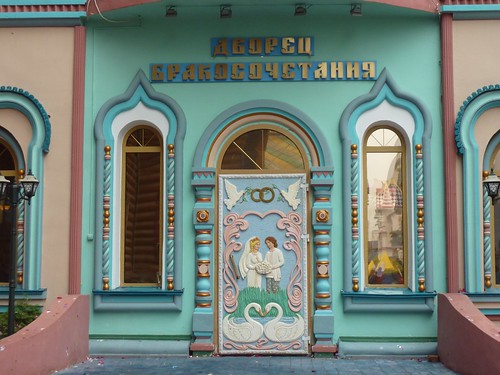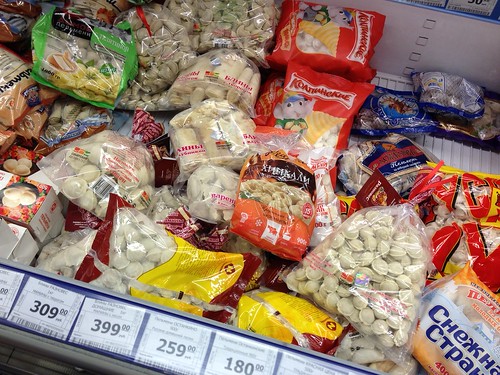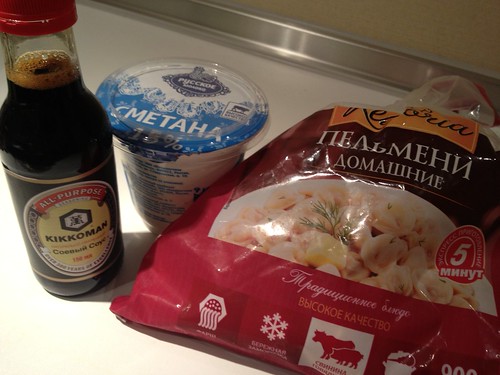I've scraped up a few minutes to get this post together, but I think we all need to get comfortable with the idea that my blogging days are pretty much over until this gig is done. I might get a chance to compose a few words over Christmas, but I'm not making any promises. (Especially now that Santa is scheduled to bring some very very very overdue props on Christmas Day, which will require immediate assembly and re-fit, thus effectively killing the three days off we were scheduled to have for the holiday. Ho Ho Ho.) For now though, let's look back on a rainy Saturday in Moscow, which seems like a lifetime ago.
When last we left our intrepid heroes (me and Gerald), we'd just strolled out of the Cathedral of Christ the Saviour and onto the pedestrian bridge across the Moscow river. Our next stop was perhaps Moscow's most infamous landmark, a colossus of steel, bronze and copper unveiled in 1997.
The Peter the Great Statue was commissioned to mark 300 years of the Russian navy, and has been controversial from the beginning. Certainly it's, err... large. At 98 metres high it's the eighth tallest statue in the world, positively dwarfing the Statue of Liberty (a mere 46m, not including the pedestal) but falling well short of assorted Buddhas and emperors scattered about the Far East. And I don't think anyone could challenge the assertion that the design lacks a certain... refinement. It frankly bristles with spars and flags and assorted naval accoutrements, and Peter is weirdly outsized, making him look like he's riding a toy boat. In 2008 it made a Top Ten list of the ugliest statues in the world.
Mostly, though, I think Muscovites hate the statue because Moscow is a very odd place to put a statue commemorating Peter the Great. After all, Peter did move the capital of Russia away from Moscow (which he hated) to St. Petersburg, a city he named after himself. So you can understand why Muscovites might be touchy about having a 300 foot tall black, spiky thing commemorating him in the middle of their city. There's also a rumour that the statue was originally designed to commemorate the 500th anniversary of Christopher Columbus's first voyage, but was repurposed with a Russian theme when no American buyer could be found. The designer - Zurab Tsereteli - denies this claim. And, in an interesting tie-in to Part One of this blog post from a hundred years ago, Zurab Tsereteli was also one of the designers of the Cathedral of Christ the Saviour. Apparently he was a great buddy of Yury Luzhkov, the Mayor of Moscow at the time. After Luzhkov left office, the new city government offered to relocate the statue to St. Petersburg, but the good folks up north politely declined the offer.
Moving right along (and after a brief moment being trapped on the island that is home to the Peter the Great Statue) Gerald and I continued our rainy walk along the south bank of the Moscow River. Our next stop was one we stumbled onto by accident, but turned out to be quite excellent. Fallen Monument Park is an appropriately bizarre and unexpected little corner of Moscow situated in the green space surrounding the huge Tretyakov Gallery. According to Wikipedia: "In October 1991, when the Soviet Union collapsed, smaller socialist realism statues of Soviet leaders and unidentifiable workers and peasants were removed from their pedestals, hauled to the park and left in their fallen form."
Alongside the obligatory statues of Russian leaders, including lots and lots of Lenins and Stalins and a smattering of Kruschevs and even a Brezhnev or two, there were also some Pushkins and many other unidentifiable folks. It was a marvellous place for a photo op, and since I was with a buddy I got a great shot of me, my fuzzy hat, and Lenin. (Just for you, Rob H.)
The statue park was a lovely unexpected find, and even though it was wet and cold, we had a great time wandering in the mud and posing. It's definitely a spot worth seeking out the next time you've got an hour to kill in central Moscow.
Then a little further along, in front of the main gallery building, Gerald was compelled to take a photo of this:
As the sunlight started to fade, we finally made our way into Gorky Park, our ultimate destination. I'd been through the park on a couple of runs earlier in the summer, and was supremely impressed with the renovations they've done since I first visited Moscow only a few years ago. Astute Go See Run Eat Drink readers will remember that Gorky Park was a sort of run down and seedy amusement park back then, populated by Whack-a-Mole games, the obligatory garden-sized train set, and one sorry camel. I'm happy to say that the park has turned around completely. In the summer there are big areas of lush grass covered with giant beanbag chairs. And there are restaurants and concerts and bright lights and all manner of friendly diversions. But in the winter? Ah, in the winter, it's even better.
I should have realised that the Russians would do winter well, as evidenced by the marvellous construction that popped up in Gorky Park sometime after the temperatures starting falling. The area that used to house the big beanbags is now covered in the largest outdoor skating rink I've ever seen.
So Gerald and I strolled through Gorky Park, which was genuinely magical, especially after dark. And we made plans to come back and skate, which never came to fruition, and we eventually made our way across a funny pedestrian bridge and back to the Metro, having walked about 10km in the cold and having had an unplanned but fantastic day in Moscow.
That Saturday already feels like a hundred years ago. I've been in Krasnodar for 3 weeks now and will make the move to Sochi in just 8 days. Krasnodar has been lovely. There are shops and restaurants and cafés a short walk from the hotel, and we've finally got into a bit of a routine with rehearsals. Of course this means that it's almost time to pack up and move to the next part. That's always the way with these gigs. You start a new phase and you scramble and rush to figure everything out and just when you start to get a handle on it, everything changes again and you're back to scrambling and rushing. But first it'll be Christmas in Krasnodar, and a tiny bit of a break, and maybe even a turkey dinner and a bit of mulled wine and a few gingerbread cookies.
When last we left our intrepid heroes (me and Gerald), we'd just strolled out of the Cathedral of Christ the Saviour and onto the pedestrian bridge across the Moscow river. Our next stop was perhaps Moscow's most infamous landmark, a colossus of steel, bronze and copper unveiled in 1997.
The Peter the Great Statue was commissioned to mark 300 years of the Russian navy, and has been controversial from the beginning. Certainly it's, err... large. At 98 metres high it's the eighth tallest statue in the world, positively dwarfing the Statue of Liberty (a mere 46m, not including the pedestal) but falling well short of assorted Buddhas and emperors scattered about the Far East. And I don't think anyone could challenge the assertion that the design lacks a certain... refinement. It frankly bristles with spars and flags and assorted naval accoutrements, and Peter is weirdly outsized, making him look like he's riding a toy boat. In 2008 it made a Top Ten list of the ugliest statues in the world.
Mostly, though, I think Muscovites hate the statue because Moscow is a very odd place to put a statue commemorating Peter the Great. After all, Peter did move the capital of Russia away from Moscow (which he hated) to St. Petersburg, a city he named after himself. So you can understand why Muscovites might be touchy about having a 300 foot tall black, spiky thing commemorating him in the middle of their city. There's also a rumour that the statue was originally designed to commemorate the 500th anniversary of Christopher Columbus's first voyage, but was repurposed with a Russian theme when no American buyer could be found. The designer - Zurab Tsereteli - denies this claim. And, in an interesting tie-in to Part One of this blog post from a hundred years ago, Zurab Tsereteli was also one of the designers of the Cathedral of Christ the Saviour. Apparently he was a great buddy of Yury Luzhkov, the Mayor of Moscow at the time. After Luzhkov left office, the new city government offered to relocate the statue to St. Petersburg, but the good folks up north politely declined the offer.
Moving right along (and after a brief moment being trapped on the island that is home to the Peter the Great Statue) Gerald and I continued our rainy walk along the south bank of the Moscow River. Our next stop was one we stumbled onto by accident, but turned out to be quite excellent. Fallen Monument Park is an appropriately bizarre and unexpected little corner of Moscow situated in the green space surrounding the huge Tretyakov Gallery. According to Wikipedia: "In October 1991, when the Soviet Union collapsed, smaller socialist realism statues of Soviet leaders and unidentifiable workers and peasants were removed from their pedestals, hauled to the park and left in their fallen form."
As you can see, they've now been reinstated.
And how could you not take a picture of this?
Then a little further along, in front of the main gallery building, Gerald was compelled to take a photo of this:
We like to call this one "Does this hammer make my ass look big?"
(Answer: No, no, a thousand times, no.
And, Mr. Soviet Hammer Guy, are you free for drinks later?)
And, Mr. Soviet Hammer Guy, are you free for drinks later?)
I should have realised that the Russians would do winter well, as evidenced by the marvellous construction that popped up in Gorky Park sometime after the temperatures starting falling. The area that used to house the big beanbags is now covered in the largest outdoor skating rink I've ever seen.
This was just one section. And I think that forest of coloured poles in the middle must have been some kind of light sculpture, though we didn't see it light up.
The whole ice area is surrounded by raised wooden walkways that let onlookers stroll around watching the action on the ice below. It was fantastic. Little did we know that the most fantastic part was yet to come.
LIGHTS! UNDER THE ICE! Chasing, colours LED lights installed UNDER THE FREAKIN' ICE! As a Canadian I tend to think we've got a bit of a monopoly of the celebration of winter, but Russia, I take my toque off to you. That ice rink at Gorky Park was a revelation.
And just when I thought it couldn't get cooler, I realised that the ice extended for approximately 8 zillion miles, and ALL OF IT had those lights. Seriously, seriously cool.
That Saturday already feels like a hundred years ago. I've been in Krasnodar for 3 weeks now and will make the move to Sochi in just 8 days. Krasnodar has been lovely. There are shops and restaurants and cafés a short walk from the hotel, and we've finally got into a bit of a routine with rehearsals. Of course this means that it's almost time to pack up and move to the next part. That's always the way with these gigs. You start a new phase and you scramble and rush to figure everything out and just when you start to get a handle on it, everything changes again and you're back to scrambling and rushing. But first it'll be Christmas in Krasnodar, and a tiny bit of a break, and maybe even a turkey dinner and a bit of mulled wine and a few gingerbread cookies.

